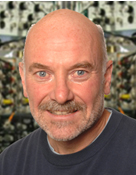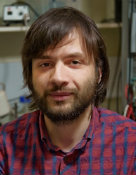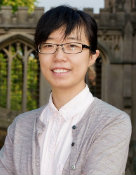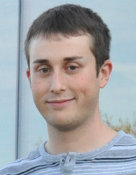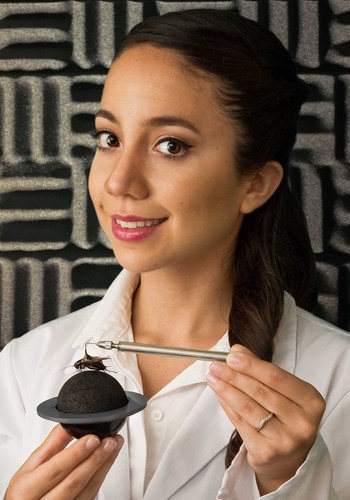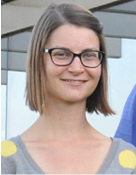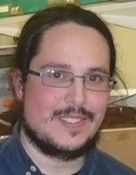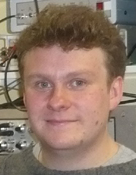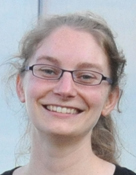Current Lab Members
|
|
Berthold Hedwig: bh202@cam.ac.ukI am the leader of this neurobiology research group. We all have a strong interest in exploring the behaviour and nervous system of insects, which use sounds to communicate. This is an exciting and rewarding endeavour. I am always keen to develop new methods and approaches, which allow us to gain an even deeper and more comprehensive understanding of our research topic. Work in my group may be demanding, but I always try to give my group members the best possible support to achieve their goals. Please have a look at our projects, and feel free to visit the lab, if you are interested in our research. |
|
|
|
||
 |
Steve Rogers: smr34@cam.ac.ukI joined the group in October 2017 as a post-doc. I am working on a BBSRC funded project that seeks to understand neural basis of pattern recognition by analysing how neural circuits in the brains of female crickets mediate the recognition of male courtship songs and organise appropriate behavioural responses. Cricket songs, as well as other rhythmic acoustic communication systems consist of periods of sound (‘pulses’) separated by periods of silence (‘intervals’) occurring in a complex but stereotyped pattern. Pattern recognition depends on the nervous system detecting both pulses and interval durations. My work consists of trying to understand how different brain neurons and neural circuits respond to these different individual elements of the calling song and how these are then combined to allow overall pattern recognition. Previously I have worked on the neuroethology of locust phase change at the University of Cambridge, the University of Sydney and Arizona State University. |
|
|
|
Chu-Cheng Lin: ccl47@cam.ac.ukI am from Taiwan and started my PhD in 2016. I have a keen interest in insect behaviour and aim to analyse the command neurons which control singing behaviour in different species of crickets. Currently I am practicing intracellular recordings in cricket auditory interneurons to work out the mechanism of mutual inhibition in the Omega Neurons ON1 and explore ways for quantitative selection of phonotactic active crickets |
|
|
|
Athanasios Ntelezos: an478@cam.ac.ukI studied Electrical and Computer Engineering at the University of Patras, Greece, followed by an MSc in Signal Processing in the University of Strathclyde. I am currently conducting research on the accuracy of phonotaxis walking and steering behavior in female crickets using a moving speaker system and also EMG recordings from steering muscles. |
|
|
|
Xinyang Zhang: xz334@cam.ac.ukI graduated in Beijing and received my MS in Entomology from Texas A&M University. During my studies I became imperceptibly convinced to study neurobiology, especially with electrophysiological techniques for a deeper insight in neuroethology. I started my PhD in 2016 and now I study brain neuron in crickets to reveal the neural circuitry from receiving, recognizing, and processing of acoustic signals to generating the motor commands for phonotactic behaviour. |
|
|
|
Matt Isaacson: mdi26@cam.ac.ukI graduated at the University of Florida with a BSc in Chemical Engineering. I started my PhD in 2014 in Cambridge developing a method for electrophoretic labelling of insect neurons with fluorescent tracers. I am now working in M. Reisers lab at Janelia Farm on visual processing in Drosophila.
|
|
Recent Members
Edith Julieta Sarmiento-PonceWas a PhD student in my lab who focused on understanding the pathways that regulate phonotaxis in female crickets, using a trackball system and computer generated sound patterns. |
||
|
|
Hannah HaberkernWhile in my lab Hannah analysed how crickets integrate antennal and auditory stimuli during phonotaxis. Interestingly antennal stimulation and active antennal exploration of objects suppresses phonotactic steering. At Janelia Farm she developed a virtual environment for visually guided behavior in Drosophila in Vivek Jaramayans lab at Janelia Farm. |
|
|
|
||
|
|
Joaquim "Pedro" JacobPedro graduated in Lisbon, his PhD project was supported by the Portuguese Champalimaud Foundation. He anlysed the singing CPG of field crickets with intracellular recordings and selective lesion experiments. Moreover he compared interneurons of the singing CPG in different species. Pedro is now post-doc in Scott Waddell's lab in Oxford. |
|
|
|
Timothy BayleyTim was funded by the MRC. His PhD project focused on optical imaging of neuronal motor activity in larval Drosophila with genetically encoded calcium reporters, and in bush-cricket antennal interneurons with intracellular loading with calcium sensitive dyes. Tim is now training in industry.
|
|
|
|
Kelly SeagravesKelly analysed how crickets may use phase differences between sound waves approaching the left and right hearing organ. She then continues to work on vocalization in mice in Roian Egnor's lab at Janelia Farm. Kelly is now at Princeton University.
|
|
|
|
Stefan SchoeneichStefan was a BBSRC research associate and systematically explored the neuronal mechanism underlying auditory pattern recognition in the cricket brain. He identified interneurons of the cricket singing-CPG, which revealed that the CPG is located in the abdominal ganglia. Stefan also analysed corollary discharge mechanisms that modulate the activity of cercal interneurons in singing crickets. Stefan is now post-doc at Leipzig University. |
|
|
|
Konstantinos KostarakosKostas came from Graz University/Austria and was a Royal Society Newton Fellow in my lab. He identified crucial local auditory interneurons in the cricket brain and moreover identified a local non-spiking interneuron, that forms a delay-line in the pattern recognition network. |
Edith Julieta Sarmiento-Ponce: js2139@cam.ac.ukI am in the fourth year of my PhD. I did my undergraduate in Biology in Mexico, and my Master in Marine Mammal Science at the University of St Andrews. My PhD focuses on understanding the pathways that regulate phonotaxis in female crickets, which I study in the lab using a trackball system and computer generated sound patterns. |

